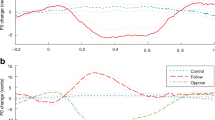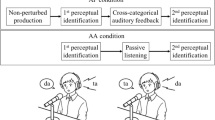Abstract
The precision of speech production is strongly influenced by the auditory feedback of our voice. Studies have demonstrated that when speakers receive perturbed auditory feedback, they spontaneously change their articulation to reduce the difference between the intended sound and what was heard. For controlling the accuracy of vowel and consonant production, this corrective behavior reflects the intended sound’s category represented in the mind. This in turn suggests that sounds that are not represented as a category would be controlled differently. The current study investigated the effect of linguistic status on controlling the production of a sound. Participants used an apparatus to produce a bistable sound, which could be heard either as a vowel or an acoustic buzz depending on the instructions. During the production of the target sound, their auditory feedback was perturbed and the change in acoustics in response to the perturbation was measured. The results showed that the group producing a linguistic target exhibited an error-reducing behavior similar to what was reported in natural vowel production, whereas the group producing a non-linguistic acoustic target exhibited an error-amplifying behavior, even when the majority in this group had noticed the perturbation and consciously tried to counteract it. Our findings indicate that access to a stable representation differentiates the perceptual organization of auditory feedback, and consequently changes how the production of the sound is controlled.






Similar content being viewed by others
References
Bunton K (2008) Speech versus nonspeech: different tasks, different neural organization. Semin Speech Lang 29(4):267–275. https://doi.org/10.1055/s-0028-1103390
Burnett TA, Freedland MB, Larson CR, Hain TC (1998) Voice f0 responses to manipulations in pitch feedback. J Acoust Soc Am 103:3153–3161
Casserly ED (2011) Speaker compensation for local perturbation of fricative acoustic feed- back. J Acoust Soc Am 129:2181–2190
Chiba T, Kajiyama M (1941) The vowel: its nature and structure. Kaiseikan, Tokyo
Cowie RJ, Douglas-Cowie E (1992) Postlingually acquired deafness: speech deterioration and the wider consequences. Mouton De Gruyter, New York
Dudley H, Tarnoczy TH (1950) The speaking machine of Wolfgang von Kempelen. J Acoust Soc Am 22:151–166
Fant G (1960) Acoustic theory of speech production. Mouton, The Hague
Fitch WT, Giedd J (1999) Morphology and development of the human vocal tract: a study using magnetic resonance imaging. J Acoust Soc Am 106:1511–1522
Gentil M, Gay T (1986) Neuromuscular specialization of the mandibular motor system: speech versus non-speech movements. Speech Commun 5:69–82
Guenther FH (2016) Neural control of speech. MIT Press, Cambridge
Hickok G (2014) The architecture of speech production and the role of the phoneme in speech processing. Lang Cogn Neurosci 29:2–20
Hopp JJ, Fuchs AF (2004) The characteristics and neuronal substrate of saccadic eye movement plasticity. Prog Neurobiol 72:27–53
Houde JF, Jordan MI (1998) Sensorimotor adaptation in speech production. Science 279:1213–1216
Jones JA, Munhall KG (2000) Perceptual calibration of F0 production: evidence from feedback perturbation. J Acoust Soc Am 108:1246–1251
Khoshkhoo S, Leonard MK, Mesgarani N, Chang EF (2018) Neural correlates of sine-wave speech intelligibility in human frontal and temporal cortex. Brain Lang 187:83–91
Lametti DR, Nasir SM, Ostry DJ (2012) Sensory preference in speech production revealed by simultaneous alteration of auditory and somatosensory feedback. J Neurosci 32:9351–9358
MacDonald EN, Goldberg R, Munhall KG (2010) Compensation in response to real-time formant perturbations of different magnitude. J Acoust Soc Am 127:1059–1068
Mitsuya T, MacDonald EN, Purcell DW, Munhall KG (2011) A cross-language study of compensation in response to real-time formant perturbation. J Acoust Soc Am 130:2978–2986
Mitsuya T, Samson F, Ménard L, Munhall KG (2013) Language dependent vowel representation in speech production. J Acoust Soc Am 133:2993–3003
Mitsuya T, MacDonald EN, Munhall KG, Purcell DW (2015) Formant compensation for auditory feedback with English vowels. J Acoust Soc Am 138:413–424
Munhall KG, MacDonald EN, Byrne SK, Johnsrude I (2009) Speakers alter vowel production in response to real-time formant perturbation even when instructed to resist compensation. J Acoust Soc Am 125:384–390
Nasir SM, Ostry DJ (2006) Somatosensory precision in speech production. Curr Biol 16:1918–1923
Niziolek CA, Guenther FH (2013) Vowel category boundaries enhance cortical and behavioral responses to speech feedback alterations. J Neurosci 33:12090–12098
Orfanidis SJ (1988) Optimum signal processing: an introduction. McGraw-Hill, New York
Ostry DJ, Munhall KG (1994) Control of jaw orientation and position in mastication and speech. J Neurophysiol 71:1528–1545
Perkell JS, Matthies ML, Svirsky MA, Jordan MI (1993) Trading relations between tongue-body raising and lip rounding in production of the vowel/u: a pilot “motor equivalence” study. J Acoust Soc Am 93:2948–2961
Perkell J, Matthies M, Lane H, Guenther F, Wilhelms-Tricarico R, Wozniak J, Guiod P (1997) Speech motor control: acoustic goals, saturation effects, auditory feed- back and internal models. Speech Commun 22:227–250
Purcell DW, Munhall KG (2006) Adaptive control of vowel formant frequency: evidence from real-time formant manipulation. J Acoust Soc Am 120:966–977
Reilly KJ, Dougherty KE (2013) The role of vowel perceptual cues in compensatory responses to perturbations of speech auditory feedback. J Acoust Soc Am 134:1314–1323
Remez RE, Rubin PE, Pisoni DB, Carrell TD (1981) Speech perception without traditional speech cues. Science 212:947–949
Remez RE, Pardo JS, Piorkowski RL, Rubin PE (2001) On the bistability of sine wave analogues of speech. Psychol Sci 12:24–29
Schenk BS, Baumgartner WD, Hamzavi JS (2003) Effects of the loss of auditory feedback on segmental parameters of vowels of postlingually deafened speakers. Auris Nasau Larynx 30:333–339
Shadmehr R, Mussa-Ivaldi FA (1994) Adaptive representation of dynamics during learning of a motor task. J Neurosci 14:3208–3224
Shiller DM, Sato M, Gracco VL, Baum SR (2009) Perceptual recalibration of speech sounds following speech motor learning. J Acoust Soc Am 125:1103–1113
Taylor AM, Rebby D (2010) The contribution of source-filter theory to mammal vocal communication research. J Zool 280:221–236
Titze IR, Baken R, Bozeman K, Granqvist S, Henrich N, Herbst C, Howard D, Hunter E, Kaelin D, Kent R, Kreiman J, Kob M, Lofqvist A, McCoy S, Miller D, Noe H, Scherer R, Smith J, Story BH, Svec J, Ternstrom S, Wolfe J (2015) Toward a consensus on symbolic notation of harmonics, resonances, and formants in vocalization. J Acoust Soc Am 137:3005–3007
Todorov E (2004) Optimality principles in sensorimotor control. Nat Neurosci 7:907–915
Tremblay S, Houle G, Ostry DJ (2008) Specificity of speech motor learning. J Neurosci 28:2426–2434
Waldstein RS (1990) Effects of postlingual deadness on speech production: implications for the role of auditory feedback. J Acoust Soc Am 88:2099–2114
Wells JC (1982) Accents of English, vol 1. Cambridge University Press, Cambridge
Acknowledgements
This research was supported by a Grant from the Natural Sciences and Engineering Research Council of Canada (NSERC), and partially supported by The National Institute on Deafness and Other Communication Disorders (NIDCD) Grant R01 DC014510. The authors wish to thank Dr. Mark Tiede for the MRI images used in Fig. 1.
Author information
Authors and Affiliations
Corresponding author
Ethics declarations
Conflict of interest
The authors declare that they have no conflict of interest.
Ethical approval
All procedures performed in studies involving human participants were in accordance with the ethical standards of the institutional and/or national research committee and with the 1964 Helsinki declaration and its later amendments or comparable ethical standards.
Additional information
Publisher's Note
Springer Nature remains neutral with regard to jurisdictional claims in published maps and institutional affiliations.
Rights and permissions
About this article
Cite this article
Mitsuya, T., Munhall, K.G. The influence of bistable auditory feedback on speech motor control. Exp Brain Res 237, 3155–3163 (2019). https://doi.org/10.1007/s00221-019-05657-1
Received:
Accepted:
Published:
Issue Date:
DOI: https://doi.org/10.1007/s00221-019-05657-1




